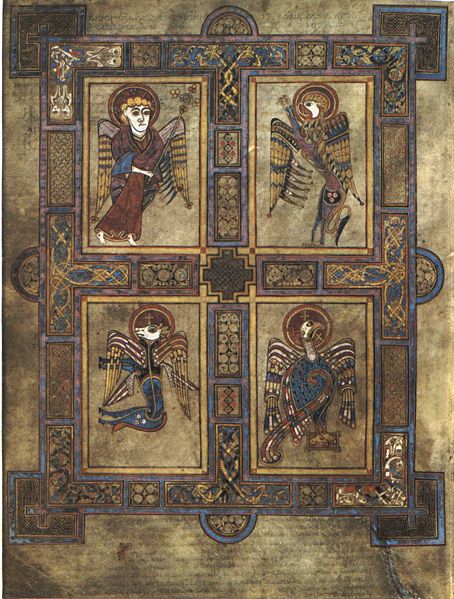The Book of Kells is an illuminated manuscript and Celtic Gospel book in Latin, containing the four Gospels of the New Testament together with various prefatory texts and tables. It was created in a Columban monastery in either Ireland or Scotland, and may have had contributions from various Columban institutions from each of these areas. It is believed to have been created c. 800 AD. The text of the Gospels is largely drawn from the Vulgate, although it also includes several passages drawn from the earlier versions of the Bible known as the Vetus Latina. It is regarded as a masterwork of Western calligraphy and the pinnacle of Insular illumination. The manuscript takes its name from the Abbey of Kells, County Meath, which was its home for centuries.
Christ enthroned.
The Book of Kells, (folio 292r), circa 800, showing the lavishly decorated text that opens the Gospel of John
Folio 27r from the Lindisfarne Gospels contains the incipit Liber generationis of the Gospel of Matthew. Compare this page with the corresponding page from the Book of Kells (see here), especially the form of the Lib monogram.
Folio 27v contains the symbols of the Four Evangelists (clockwise from top left): an angel (Matthew), a lion (Mark), an eagle (John) and an ox (Luke)
An illuminated manuscript is a formally prepared document where the text is decorated with flourishes such as borders and miniature illustrations. Often used in the Roman Catholic Church for prayers and liturgical books such as psalters and courtly literature, the practice continued into secular texts from the 13th century onward and typically include proclamations, enrolled bills, laws, charters, inventories, and deeds.
Illuminated manuscripts housed in the 16th-century Ethiopian Orthodox Church of Ura Kidane Mehret, Zege Peninsula, Lake Tana, Ethiopia
Frontispiece of the Maqamat al-Hariri (1237 CE) depicting a ruler in Turkic dress (long braids, Sharbush fur hat, boots, fitting coat), possibly Baghdad.
Page from a Latin book of hours, with miniatures of saints. Book of Hours of Alexandre Petau, 16th century, Rouen, well after printing had become more common.
The author of a manuscript at his writing desk. 14th century








